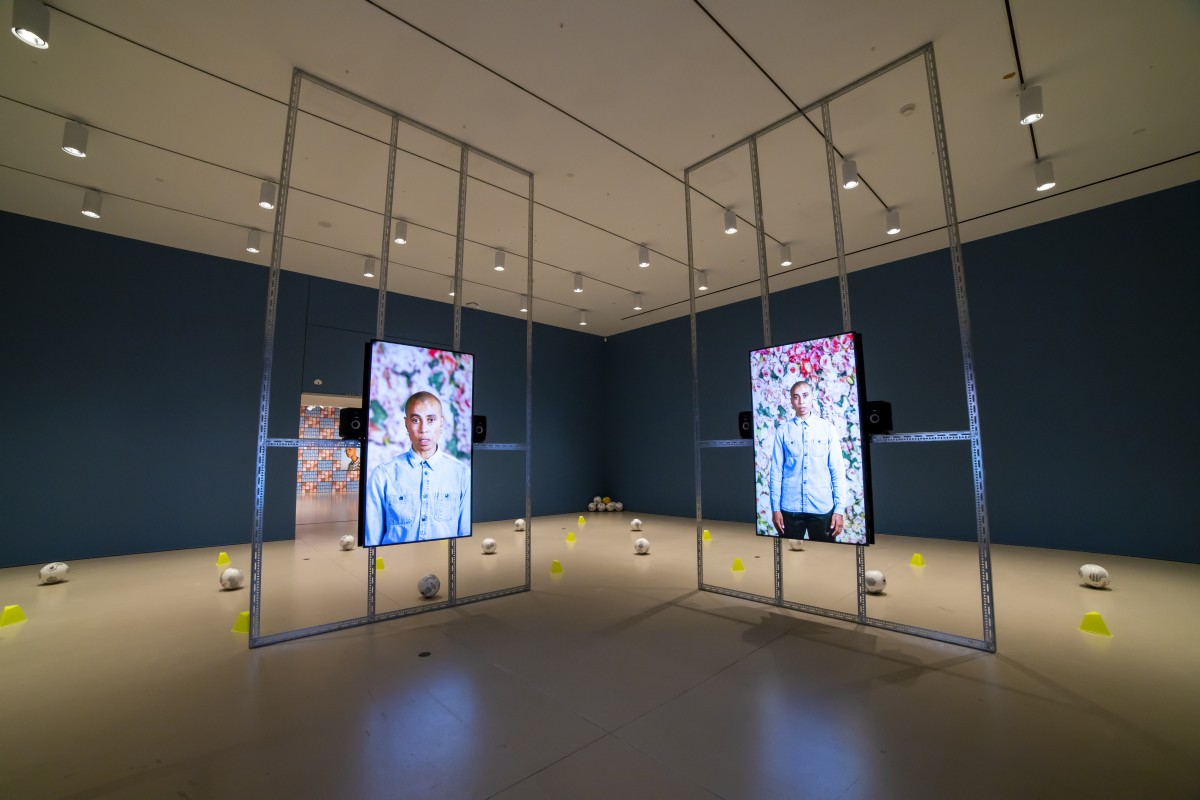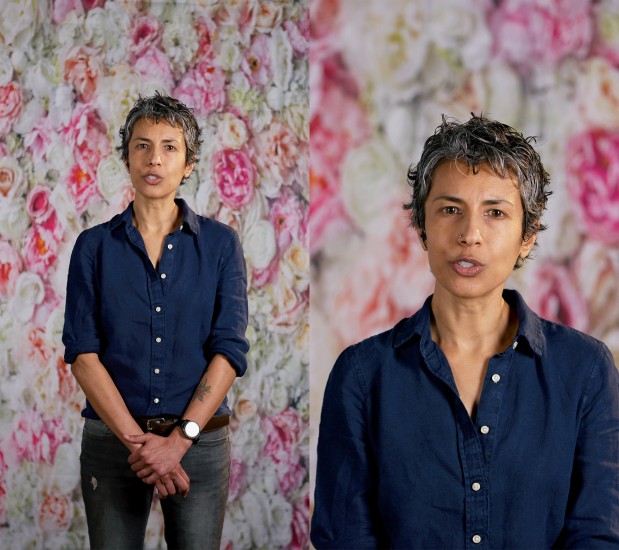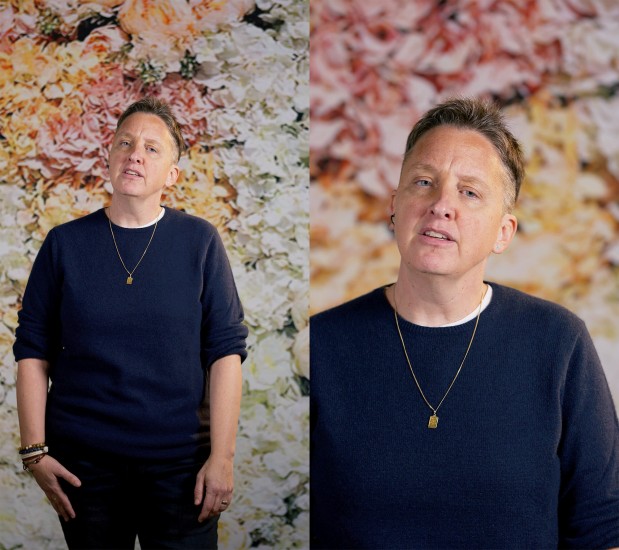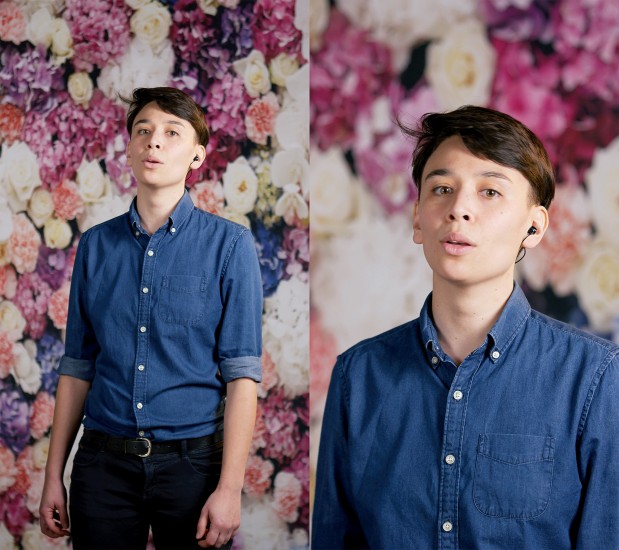In unison
Michèle Pearson Clarke learns how to sing and explores the vulnerability of queer female masculinity in her new exhibition, Muscle Memory, on view now at the Art Gallery of Hamilton.

Michèle Pearson Clarke, Quantum Choir, 2022, digital video stills, four-channel 4k video installation, Courtesy of the artist.
We tend to avoid the spotlight when we’re not good at something. But what happens when we do it anyway? What strength does it take to step wholeheartedly into vulnerability? Michèle Pearson Clarke – artist, writer, educator and Toronto’s Photo Laureate for 2019-2022 – contends with these questions and more in Muscle Memory, on view now at the Art Gallery of Hamilton (AGH) through May 2022.
Marking two firsts for Clarke – her largest showing, and her first major solo exhibition at a public gallery – Muscle Memory builds on Clarke’s explorations of Black and queer experiences centred around longing, loss, grief and trauma. Clarke traverses queer female masculinity with two works in the show: Quantum Choir (2022), a new four-channel video and sound work created specifically for the exhibition, and selections from the ongoing photo series The Animal Seems to Be Moving (2018 − present). In Quantum Choir, Clarke steps in front of the camera with three other queer masculine participants to work through the insecurity, worry and shame of being a bad singer. Constructing a queer kinship through song, the four-piece progresses through warm-ups and eventually sings John Grant’s “Queen of Denmark”. Clarke has often been perceived as being much younger than her true age and in The Animal Seems to Be Moving (2018 − present), she takes a closer at herself in a series of self-portraits to process what it means and looks like to age in a Black, queer and masculine body.
We asked Clarke a few questions to learn more about how the AGH exhibition came together.
AGOinsider: Tell us about the meaning behind the title of this exhibition Muscle Memory and how it relates to the works on view.
Clarke: We often use “muscle memory” to refer to the ways in which we perform everyday actions automatically and almost without thought. Both projects on view are inviting viewers to think about queer female masculinity, and the title conveys that internal sense around my masculinity—it just is. But the works in the exhibition are also reflecting on how queer masculine women are looked at and how we are seen, and the ways we cope with an often-negative external gaze are also automatic. Those bodily responses have been programmed through a lifetime of repetition.
AGOinsider: Both The Animal Seems to Be Moving (2018 − present) and Quantum Choir lean into vulnerability, a recurring theme in your practice. How do these works exist in dialogue with each other?
Clarke: There are probably several conversations going on between these two, but as far as vulnerability is concerned, with both works I really wanted to walk my own talk, so to speak. Many of my projects have asked other folks to be deeply vulnerable, and while I repeat that artistic gesture here with Quantum Choir, I also wanted to intentionally put myself in front of the camera alongside my community. It was a self-reflexive move and it's given me a lot to think about.
AGOinsider: Speaking of leaning into vulnerability, you and the three participants featured in Quantum Choir worked with a vocal coach [Teiya Kasahara] to learn how to sing. What was revelatory about that experience, in terms of working with an artform you are not as confident with?
Clarke: I specifically chose singing because that was one of my own greatest sources of vulnerability. I’m bad at many things, but nothing else has made me feel the kind of shame I’ve felt my whole life at being a bad singer. I’ve never done karaoke, and I would always just mouth the words if I had to sing publicly at a sporting event or a birthday party. So, it was revelatory to finally confront this lifelong struggle and come out the other side. And not just for me, I think we all feel an incredible sense of achievement and accomplishment at having stuck with the process all the way to the end. And there’s that lightness now that you feel when you let go of something heavy.
AGOinsider: As you continue your run as Toronto’s Photo Laureate this year, what are the projects you are looking forward to, of yours and of other creatives?
Clarke: I’m actually in the last few months of my Photo Laureate term, and I’ll be wrapping up my three years of service this spring. I’m ending on a high note though, and I’m really pleased to be partnering with The BIPOC Photo Mentorship Program on an outdoor exhibition at Nathan Phillips Square for Doors Open Toronto in May. BPM is a homegrown initiative that makes mentorship opportunities available to emerging BIPOC photographers, and this will be the first exhibition of photographs produced by BPM mentee participants. Our exhibition will also be part of the 2022 CONTACT Photography Festival and ArtworxTO: Toronto’s Year of Public Art, and I am definitely looking forward to seeing all of the new public art presented by both of these marvellous events.
Don’t miss Michèle Pearson Clarke: Muscle Memory on view at the Art Gallery of Hamilton (AGH) until May 23. On March 8, Clarke will be featured in a virtual conversation at the AGH. Find out more and register here. The AGH is also hosting a free weekend in celebration of their recently opened exhibitions on March 5 and 6. We connected with Clarke earlier in her term as Photo Laureate for the City of Toronto; you can read that Q&A here.
Are you an AGOinsider yet? If not, sign up to have stories like these delivered straight to your inbox every week.





